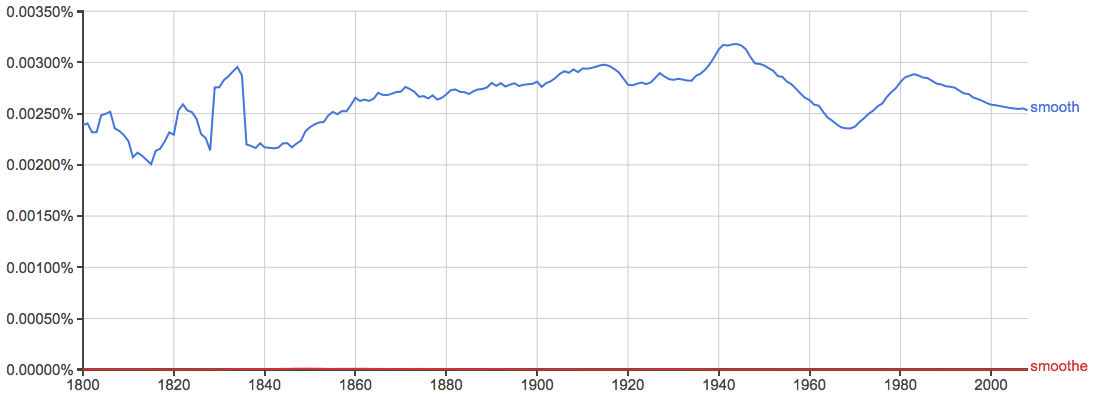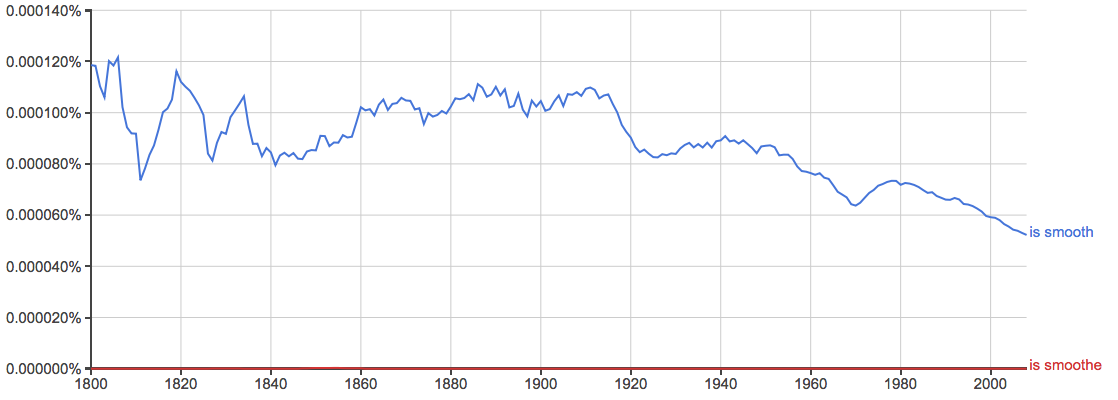So many words have multiple accepted spellings in English that it can be tempting to assume that they all do.
That is not the case, however. Smooth, for instance, seems like it could be spelled smoothe as well. If sooth and soothe are both words, how about smoothe?
There may not be a single clear answer to that question, but, in actual usage, smooth and only smooth is a commonly accepted word.
What is the Difference Between Smooth and Smoothe?
In this post, I will compare smoothe vs. smooth. I will outline the correct spelling and use it in example sentences to demonstrate its proper use.
Plus, I will show you a memory tool that you can use as a reminder of whether smoothe or smooth is correct.
When to Use Smooth
 What does smooth mean? Smooth is a versatile word that can be a verb or an adjective.
What does smooth mean? Smooth is a versatile word that can be a verb or an adjective.
As an adjective, smooth means free of bumps or wrinkles.
For example,
- Eddie completed his restoration of a classic Mustang by giving it a smooth coat of black paint.
- We had a smooth flight from Boston to Chicago, but the flight back to Boston was turbulent and uncomfortable.
- Despite a smooth start to trading, Twitter is sure to face continued scrutiny as it works to justify a valuation of $31.7 billion to investors sensitive to the nuances of quarterly earnings reports. –The New York Times
As a verb, smooth means to remove bumps or wrinkles.
For example,
- Aaron will become a better baseball player as he continues to smooth out the mechanics of his swing.
- If the top of your cake looks lumpy and imperfect, don’t worry- it will look delicious once you smooth the frosting over it.
The verb smooth is a regular verb, which means it follows the normal conjugation scheme for verbs in English.
Conjugation of Smooth:
- I/we smooth: first person singular and plural present
- You smooth: second person singular and plural present
- He/she/it smooths: third person singular present
- They smooth: third person plural present
- I/we/you/he/she/they smoothed: simple past
- Smoothing: present participle
Smooths or Smoothes? As you can see from the above conjugation chart, smooth only takes the letter “e” in the past tense. This is typical for regular verbs, which smooth is.
What this means is that not only is smoothe a spelling error but so is smoothes.
When to Use Smoothe
 What does smoothe mean? Smoothe is a misspelling of smooth. It is easy to understand why smoothe seems to make sense. After all, the word soothe rhymes with smooth and has a silent E.
What does smoothe mean? Smoothe is a misspelling of smooth. It is easy to understand why smoothe seems to make sense. After all, the word soothe rhymes with smooth and has a silent E.
The simple past tense of soothe is soothed, just like smooth and smoothed. To someone unfamiliar with English verbs, it is intuitive that the E would have to come from somewhere.
Still, smoothe is a misspelling of smooth. The charts below shows the relative usage of smooth vs. smoothe as a verb in English since 1800.


As you can see, smoothe has never seen widespread use and hardly registers a blip over the last 200 years.
Trick to Remember the Difference
Smooth is the only correct version of this verb, but how can we remember this fact?
Smoothe has an extra E. Since it is an error, and both smoothe and error contain the letter E, it will be an easy task to remember that smoothe is an error.
Summary
Is it smooth or smoothe? Smooth is a verb that means to remove bumps and wrinkles. It is also an adjective that means free from bumps and wrinkles.
- Smooth is the correct spelling.
- Smoothe is a misspelling of smooth.
Contents
